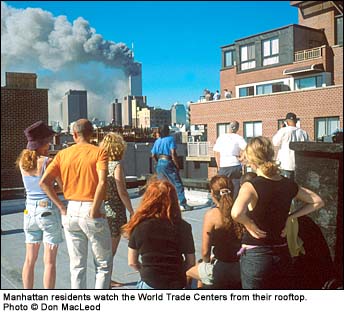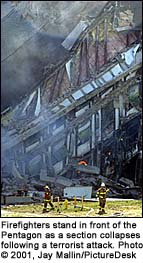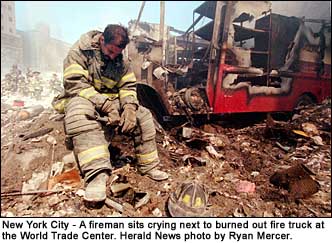 Don
MacLeod: Don
MacLeod:
When I heard the news, I grabbed my cameras and ran up three flights
of stairs to the roof of my building in Little Italy. My neighbors
were already there, silently watching the collapse of the South
Tower. There wasn't much to say; we all stood there watching, not
talking. Normally we go the roof for Fourth of July fireworks or
to sunbathe or to have a summertime party. Watching the towers fall
on an otherwise perfect September morning was so incomprehensible
that nobody at the time seemed to realize the enormity of it. The
attack seemed to happen in slow motion. For those us far enough
removed geographically from the site, what we were watching was
surreal. It wasn't frightening or moving. The attack looked like
an almost prim performance of catastrophe. The terrorists wanted
to make an immense show; they certainly had an audience for their
murderous handiwork.
While the rest of New York slowly returned to routine, work continued
around the clock at Ground Zero. Rescuers worked through the clouds
of smoke from still-burning fires and the thick dust raised by every
move they made. The site was lit by portable floodlights brought
to the scene the night of the attack. This shot was taken at 11:00
PM, Sept. 16, five days after the attack. At the time, there was
still hope of rescuing survivors and the list of the missing was
still estimated to be below 5,000. |
|

Jay Mallin:
I was at the Pentagon early on, and the photos taken an hour or
so later, when the media had been pushed much further back, don't
convey the destruction of the attack. The Pentagon itself is so
huge, the gap blown in it looks small by comparison. What was
really stunning, standing there, was that there was no sign of
the plane itself. This was a big plane with a lot of local people
in it, people from my neighborhood, and it hit that building so
hard it seems to have vanished into nothing.
|
|
|
|

Ryan
Mercer, Chief Photographer, Herald News, Passaic County, NJ
I got caught in a blast of dust 2-3 blocks from Ground Zero. It
swallowed you up, everything went deathly quiet and completely
black. For sixty seconds I had no idea how I was going to get
out. Then I took a lens cleaning cloth covered with a polymer
to breathe through. I found another man in a similar situation,
we walked out together and I brought him to an ambulance. After
I calmed down, I went back in to get my job done.
|
Gilbert
Plantinga:
I went down to the New York State Armory, where they were gathering
missing persons information. The camera crews were there, doing
head-and-shoulders of people holding up flyers pleading for help
for their loved ones. I couldn't help but think that there was little
that I could do for these people with my still photos, but that
the television guys probably weren't doing that much good either.
I had to break through some sort of empathy barrier and become a
part of the scene. |
|
|
 Don
MacLeod:
Don
MacLeod:
